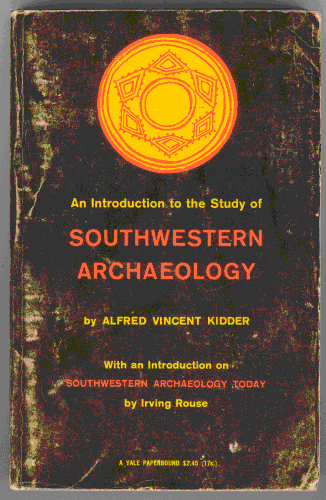
Picked it up at a library-benefit book sale last weekend. It's a classic work, but I've never read it all. This one is the second printing of the revised 1962 edition with an introduction by Irving Rouse. Some info on it here, or at least some info on the general body of work by Kidder from that time. I'm still on the Introduction at the moment, but it's interesting how nonchalant Rouse is when discussing possible pre-Clovis sites. This was only a few years after C14 dating had been invented so there are a lot dates well before 12.5k BP, but Rouse was careful to note that many had dubious associations. (Kidder bio here too)
Kidder was influential with this work, and his work at Pecos in general for a number of reasons. It wasn't the first stratigraphic excavation, nor was it the first time anyone had attempted to order ceramics by (absolute) frequency. But Kidder was the first to note the relative frequencies of ceramic types through time (via stratigraphy) as well. his interest in doing so probably resulted because he had trained under George Reisner the Egyptologist who had also trained under Petrie who had used a form of seriation in Egypt.
This has always been a connection that has fascinated me, but I've never been able to pin down exactly what influence Petrie's Sequence Dating scheme had on Americanist archaeology. I'm pretty sure that American archaeologists were aware of what Petrie was doing, but none of them seem to acknowledge any sort of direct borrowing of Petrie's methods, nor does the early work on seriation seem to have directly borrowed from it either. Lyman, O'Brien and Dunnell (1997) have this to say (refs edited out):
Kidder performed what Rowe later characterized as "ordering by continuity of features and variation in themes." This is precisely what John Evans had done in England sixty-five years earlier, and it differed markedly from Kroeber's and Spier's seriation technique, a patently American invention. Kidder probably learned the technique he used from Reisner who. . .had worked in Egypt. This was where Rowe's "ordering by continuity of features and variation in themes" was used by Petrie."
This is the impression I've had; that Petrie's methods were not really the same as that developed here though many were using similar techniques.
At any rate, I'll probably post more as I get into it.
Refs:
Kidder, A. V.
1924 An Introduction to Southwestern Archaeology. 2nd ed. Yale University Press, New Haven and London.
Lyman, R. L., M. J. O'Brien and R. C. Dunnell
1997 The rise and fall of culture history. Plenum Press, New York.